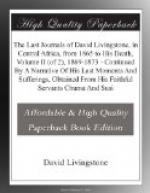In reading about the lingering sufferings of Dr. Livingstone as described by himself, and subsequently by these faithful fellows, one is quite prepared to understand their explanation, and to see why it was possible to defer these operations so long after death: they say that his frame was little more than skin and bone. Through an incision carefully made, the viscera were removed, and a quantity of salt was placed in the trunk. All noticed one very significant circumstance in the autopsy. A clot of coagulated blood, as large as a man’s hand, lay in the left side,[36] whilst Farijalapointed to the state of the lungs, which they describe as dried up, and covered with black and white patches.
The heart, with the other parts removed, were placed in a tin box, which had formerly contained flour, and decently and reverently buried in a hole dug some four feet deep on the spot where they stood. Jacob was then asked to read the Burial Service, which he did in the presence of all. The body was left to be fully exposed to the sun. No other means were taken to preserve it, beyond placing some brandy in the mouth and some on the hair; nor can one imagine for an instant that any other process would have been available either for Europeans or natives, considering the rude appliances at their disposal. The men kept watch day and night to see that no harm came to their sacred charge. Their huts surrounded the building, and had force been used to enter its strongly-barred door, the whole camp would have turned out in a moment. Once a day the position of the body was changed, but at no other time was any one allowed to approach it.
No molestation of any kind took place during the fourteen days’ exposure. At the end of this period preparations were made for retracing their steps. The corpse, by this time tolerably dried, was wrapped round in some calico, the leg being bent inwards at the knees to shorten the package. The next thing was to plan something in which to carry it, and, in the absence of planking or tools, an admirable substitute was found by stripping from a Myonga tree enough of the bark in one piece to form a cylinder, and in it their master was laid. Over this case a piece of sailcloth was sewn, and the whole package was lashed securely to a pole, so as to be carried by two men.
Jacob Wainwright was asked to carve an inscription on the large Mvula tree which stands by the place where the body rested, stating the name of Dr. Livingstone and the date of his death, and, before leaving, the men gave strict injunctions to Chitambo to keep the grass cleared away, so as to save it from the bush-fires which annually sweep over the country and destroy so many trees. Besides this, they erected close to the spot two high thick posts, with an equally strong cross-piece, like a lintel and door-posts in form, which they painted thoroughly with the tar that was intended for the boat: this sign they think will remain for a long time from the solidity of the timber. Before parting with Chitambo, they gave him a large tin biscuit-box and some newspapers, which would serve as evidence to all future travellers that a white man had been at his village.




